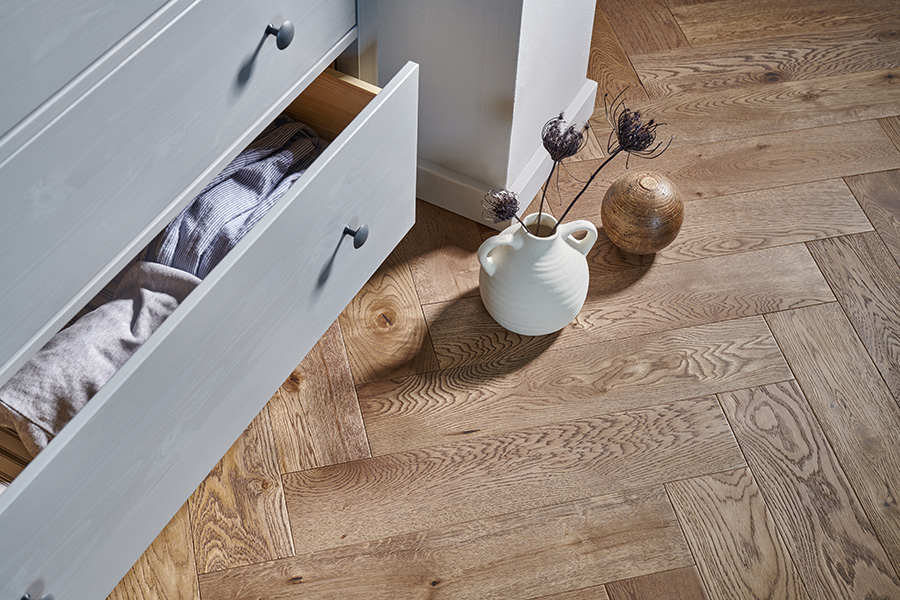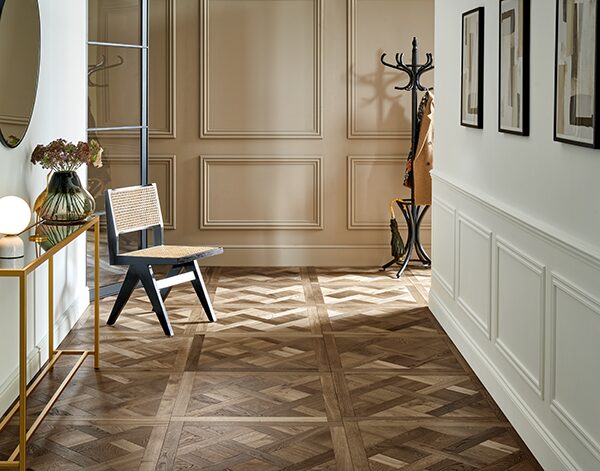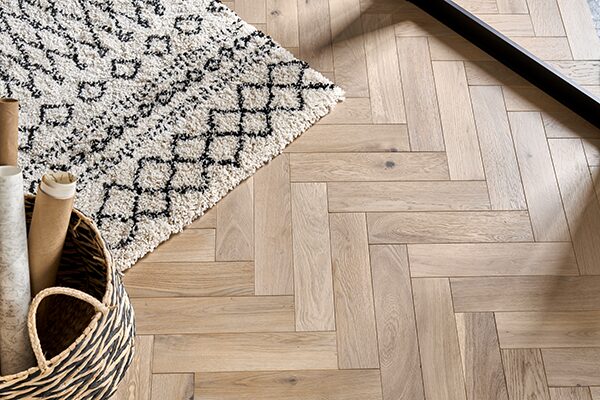Herringbone, Parquet or Chevron? Which one is right for you…

Breaking the traditions of interior design is becoming increasingly popular. If you’re looking to find alternative options to a traditional plank wood floor for your home, you’re in the right place. In this blog post, we will look at parquet, herringbone and chevron flooring. We’ll explore what each of them are and help you understand which one is right for you.
Contents
Getting things straight
Let’s start by answering the question, what is the difference between parquet, herringbone and chevron?
Parquet is an umbrella term for any wood or wood-effect flooring arranged in a geometric pattern. Herringbone and chevron are both specific types of parquet flooring patterns.
What is parquet and where did it come from?
Parquet flooring is made up of short wooden battens that are slotted together in geometric patterns.
Parquet flooring became popular in 17th century France. It was initially used in manor houses as well as public buildings such a schools and factories.
In the late 1600s, parquet floors were installed into the French royal palace at Versailles. Instead of the traditional squares of parquetry, the new “parquet de Versailles” was designed for King Louis XIV. He laid large squares on the bias, creating a pattern of diamonds. This design inspiration is what we see today in wood Design Panel flooring.
Parquet floors were popular through the 1930s when carpet became the latest trend. Many of these beautiful floors have been hidden until recently when homeowners have started to lift their carpets and reveal the beautiful floor underneath. Today’s parquet floors are a lot less expensive and more accessible than they used to be, making them an increasingly popular choice for many homeowners.
Parquet comes in many forms, but three of the most popular are herringbone, chevron and design panels. Let’s take a closer look at each.
Why herringbone flooring?
Trendy, luxurious and interesting, herringbone flooring will effortlessly transform any space. The pattern that herringbone creates allows the eye to move around the room in a more even manner. This often helps to soften the shape of the room.
Herringbone floors work well in large rooms where there is enough space for the flooring pattern to shine. Larger spaces also work well with dark herringbone shades that may overwhelm smaller rooms. Dark herringbone brings a sophisticated style to a room, making it the perfect place to entertain and host.
Pale herringbones create a light and airy space. The light ashen tones found in Goodrich Ecru Oak and Highclere Feather Oak mean that they work with a wide range of design styles. From modern farmhouse to a more clean & contemporary style, these floors will effortlessly blend with the look you’re trying to create.
Opt for a traditional style if you’re uncertain on a colour palette. Herringbone is a striking classic design, effortlessly contemporary whilst evoking a golden age. Choosing a natural or smoked herringbone floor is a safe option, the neutral colour works well with many different styles.
Natural shades allow you to tweak your interior colour scheme over time. To elevate your space, bring in subtle design accents and texture using rugs, curtains and wall art.
Why chevron flooring?
Chevron planks are cut at a 45-degree angle to create a “V” shape or zig-zag pattern. Installing these planks in straight rows creates a symmetrical, contemporary design. The intricacies of working with a chevron pattern mean that there is very little tolerance for misaligned planks. Therefore, it’s important to have the installation carried out by a professional.
Many choose to have chevron in the centre space in their home. This will often be the entry hallway, then feeding through into adjacent rooms. The symmetrical zig-zag pattern that chevron creates draws the eye down the room, making it feel elongated.
Use a pale shade, like Goodrich Raw Chevron Oak to add brightness to your room. Using lighter wood tones highlights the chevron pattern because the bevels stand out more on a lighter wood floor. Use furniture like transparent tables to add a touch of elegance without distracting from the chevron pattern.
Why design panels?
Design panels represent the finest of flooring. Each one is created by inlaying selected blocks to create patterns. These patterns are both traditional and contemporary as well as intricate and minimalist. This technique means the natural grain runs in multiple directions, allowing light and texture to add depth and interest to the floor.
Design panels are one of those showstopper floors and work well in large rooms where the floor can be the centrepiece without furniture or doors getting in the way.
For that clean style, a lighter panel option is perfect. Design panels with an ashen limed look to them like Sandringham Limed Oak will complement a Scandinavian style. Add pastel coloured artwork to your space for a subtle pop of colour.
If you’re wanting something a bit more mature and classic, Sandringham Aged Oak gives you a traditional, timeless look. Match this floor with a deep navy, natural beiges and subtle lighting to create a beautiful luxurious space. Design panels lend themselves to entertaining spaces like lounges and dining rooms.
We hope this blog has given you some insight into the different types of parquet floors and helped you understand which one is right for you.
Want more? Check out our herringbone section on our site or read more in our inspiration section…
Follow us on Instagram for tips, trick and inspiration right on your feed!





